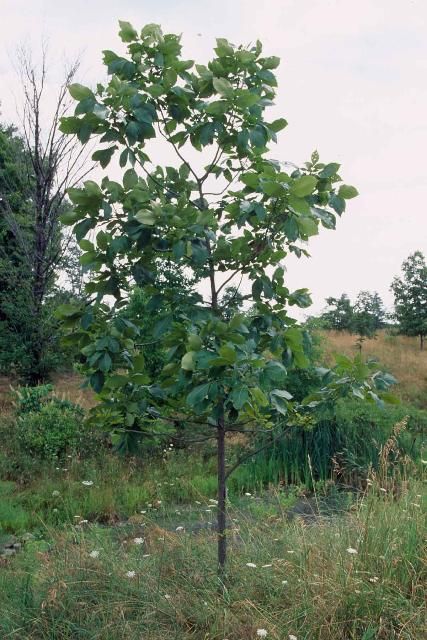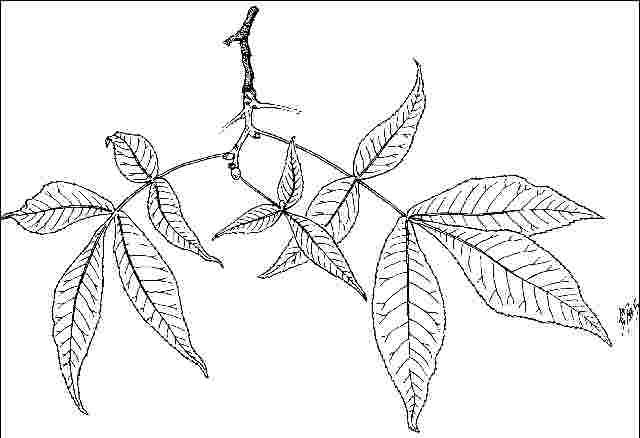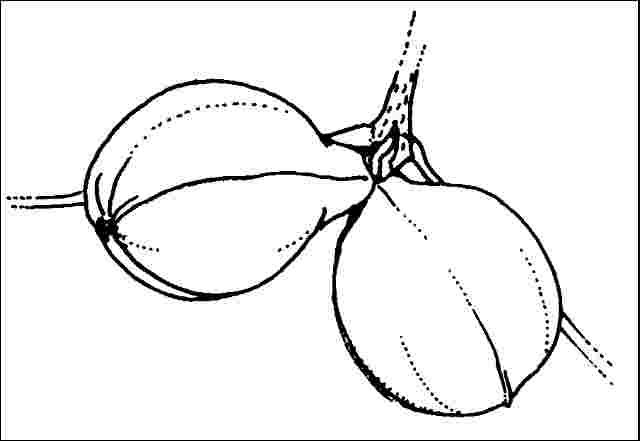Introduction
Shagbark hickory reaches a height of 60 to 80 feet and spreads 25 to 35 feet. The tree has a picturesque, oval outline with the lower branches somewhat drooping, the upper branches upright, and the middle branches just about horizontal. Probably the best ornamental hickory due to the open branching habit and shaggy, gray bark.

Credit: Ed Gilman
General Information
Scientific name: Carya ovata
Pronunciation: KAIR-ee-uh oh-VAY-tuh
Common name(s): Shagbark hickory
Family: Juglandaceae
USDA hardiness zones: 5A through 8A (Fig. 2)
Origin: native to North America
Invasive potential: little invasive potential
Uses: specimen; shade
Availability: somewhat available, may have to go out of the region to find the tree

Description
Height: 60 to 80 feet
Spread: 25 to 35 feet
Crown uniformity: symmetrical
Crown shape: oval
Crown density: moderate
Growth rate: slow
Texture: coarse
Foliage
Leaf arrangement: alternate (Fig. 3)
Leaf type: odd-pinnately compound
Leaf margin: serrate
Leaf shape: oblanceolate, oblong, lanceolate
Leaf venation: pinnate
Leaf type and persistence: deciduous
Leaf blade length: 4 to 8 inches
Leaf color: green
Fall color: yellow
Fall characteristic: showy

Flower
Flower color: green
Flower characteristics: showy
Fruit
Fruit shape: oval, round
Fruit length: 1 to 3 inches
Fruit covering: dry or hard
Fruit color: brown, green
Fruit characteristics: attracts squirrels/mammals; showy; fruit/leaves a litter problem

Trunk and Branches
Trunk/bark/branches: branches don't droop; showy; typically one trunk; thorns
Pruning requirement: little required
Breakage: resistant
Current year twig color: brown, gray
Current year twig thickness: thick
Wood specific gravity: 0.72
Culture
Light requirement: full sun, partial sun, or partial shade
Soil tolerances: clay; sand; loam; acidic; slightly alkaline; well-drained; occasionally wet
Drought tolerance: moderate
Aerosol salt tolerance: none
Other
Roots: not a problem
Winter interest: yes
Outstanding tree: yes
Ozone sensitivity: tolerant
Verticillium wilt susceptibility: susceptible
Pest resistance: resistant to pests/diseases
Use and Management
Growth rate is slow and the tree is somewhat difficult to transplant due to a coarse root system but the tree is adaptable to many different soils. There is usually a tap root on trees grown in well-drained soil. The nuts are produced in abundance and are edible and used by birds and mammals but must also be cleaned up from the ground in a maintained landscape. They can damage cars when they fall from the tree, so do not locate them near streets or parking areas. Shagbark hickory grows best in a sunny location and light well-drained soil. It grows naturally in moist river bottoms, not inundated flood plains.
The tree has two ornamental characteristics: peeling, shaggy bark, which peels off in long strips, and a golden yellow fall color. The light grey bark is quite striking. Not a tree for general use, shagbark hickory is best saved for an occasional specimen on golf courses and parks and in other open areas.
Pests
Aphids of various types feed on hickory causing distorted and stunted growth. The hickory leaf stem gall causes the formation of hollow green galls on leaves, stems, and twigs. The galls form in June and turn black in July. The galls are up to a half inch in diameter.
Hickory bark beetles mine the bark and sapwood. The boring causes wilting of young twigs, or trunks may be girdled and trees killed. Keep trees healthy by fertilizing regularly and by watering during dry weather. It can kill trees of low vigor.
The twig girdler larva girdles twigs causing weakened twigs to break off and drop. The larva is about a half-inch-long and rides the branch to the ground where it overwinters. Gather the fallen twigs and destroy them.
June beetles eat the leaves of hickory at night. The injury is usually not severe but can be mysterious since no insects are seen during the day.
Caterpillars of various types feed on hickory.
Scales of various types attack hickory but can be controlled with sprays of horticultural oil.
Spittlebugs can be a nuisance.
Diseases
Hickory anthracnose or leaf spot is caused by a fungus. In wet years the disease causes severe defoliation. The symptoms are large reddish brown spots on the upper leaf surface but brown on the lower surface. The spots may not have distinct marginal markings. The disease overwinters on fallen diseased leaves so dispose of infected leaves in the fall. A large number of fungi cause leaf spots on hickory. Severe infections can cause defoliation. Many of the fungi overwinter on diseased leaves, dispose of infected leaves when they fall.
Witches broom can follow a leaf spot disease. Symptoms are yellow blotches on the upper sides of the leaves but white on the undersides. Severe infections may cause defoliation, and when the fungus invades the stem a witches broom forms. Leaves on the stems of the witches broom are yellowish, small, and fall prematurely. Prune out witches brooms when they form.
Powdery mildew causes a white powdery growth on the leaves. If the disease occurs late in the season, no chemical control will be needed.
Try to prevent cankers by keeping trees healthy through watering during dry weather and regular fertilization. Avoid wounding the trees unnecessarily and prune out weak or dead branches.
Verticillium wilt kills individual branches or sometimes entire sections of the tree. Foliage on affected branches wilts and later turns brown. Keep trees healthy and prune out small infected branches.